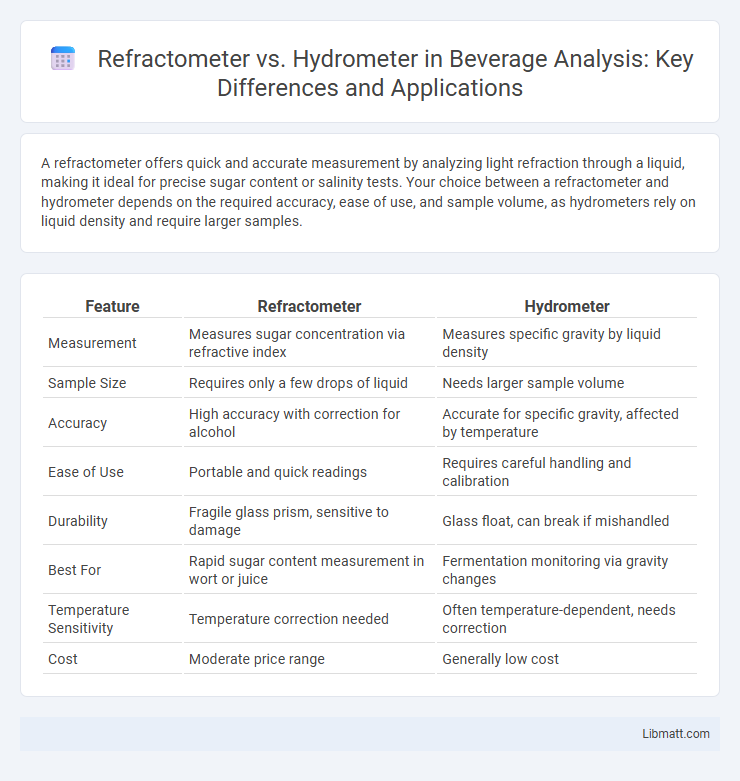A refractometer offers quick and accurate measurement by analyzing light refraction through a liquid, making it ideal for precise sugar content or salinity tests. Your choice between a refractometer and hydrometer depends on the required accuracy, ease of use, and sample volume, as hydrometers rely on liquid density and require larger samples.
Table of Comparison
| Feature | Refractometer | Hydrometer |
|---|---|---|
| Measurement | Measures sugar concentration via refractive index | Measures specific gravity by liquid density |
| Sample Size | Requires only a few drops of liquid | Needs larger sample volume |
| Accuracy | High accuracy with correction for alcohol | Accurate for specific gravity, affected by temperature |
| Ease of Use | Portable and quick readings | Requires careful handling and calibration |
| Durability | Fragile glass prism, sensitive to damage | Glass float, can break if mishandled |
| Best For | Rapid sugar content measurement in wort or juice | Fermentation monitoring via gravity changes |
| Temperature Sensitivity | Temperature correction needed | Often temperature-dependent, needs correction |
| Cost | Moderate price range | Generally low cost |
Introduction to Refractometer and Hydrometer
Refractometers and hydrometers are precise instruments used to measure the concentration of liquids, crucial in brewing, winemaking, and various scientific applications. A refractometer determines the sugar content in a solution by measuring the degree to which light is bent as it passes through the liquid, offering quick and small-sample analysis. Hydrometers measure the specific gravity or density of liquids by floating in the solution, providing direct readings essential for monitoring fermentation and quality control.
How Refractometers Work
Refractometers measure the concentration of dissolved substances by analyzing the refraction of light as it passes through a liquid sample, using the principle that light bends at different angles depending on the solution's density. This optical method provides rapid, precise readings of sugar content or salinity by detecting changes in the refractive index. Your ability to obtain accurate measurements with minimal sample volume and quick calibration makes refractometers ideal for brewing, winemaking, and quality control.
How Hydrometers Work
Hydrometers measure the specific gravity of liquids by floating in the liquid and reading the scale at the liquid's surface level, based on Archimedes' principle of buoyancy. The density of the liquid affects the hydrometer's buoyancy, allowing users to determine the concentration of substances such as sugar or alcohol in solutions. This method requires temperature correction for accurate results, as liquid density changes with temperature variations.
Key Differences Between Refractometer and Hydrometer
A refractometer measures the refractive index of a liquid to determine its sugar content quickly and requires only a few drops of sample, making it ideal for precise and rapid readings. A hydrometer measures the liquid's specific gravity by floating in the liquid, providing direct density measurements but needs a larger sample volume and more time for stabilization. Your choice depends on the required accuracy, sample size, and the specific application, such as brewing or winemaking.
Accuracy and Precision Comparison
Refractometers offer higher accuracy and precision in measuring liquid concentrations due to their ability to analyze refractive index changes with minimal sample volumes and reduced temperature sensitivity. Hydrometers, while simpler and cost-effective, can exhibit lower precision because they rely on liquid density, which fluctuates with temperature and impurities, leading to variable readings. Your choice between a refractometer and hydrometer should consider the need for consistent, accurate measurements in applications like brewing or winemaking, where small differences significantly impact quality.
Ease of Use and Maintenance
Refractometers offer greater ease of use due to their small sample size requirement and quick digital readouts, making them ideal for rapid measurements in brewing and winemaking. Hydrometers require larger liquid volumes and more careful handling to avoid breakage, with manual readings that can be prone to human error. Maintenance for refractometers involves regular calibration with distilled water, while hydrometers need delicate cleaning and proper storage to prevent damage and residue buildup.
Applications in Brewing and Winemaking
Refractometers provide rapid, accurate sugar content measurements in brewing and winemaking, enabling efficient monitoring of fermentation progress and must or wort sugar levels. Hydrometers are widely used to measure specific gravity, offering direct insights into the density and alcohol potential of beverages during fermentation and after aging. Combining refractometer and hydrometer data enhances precision in alcohol content estimation and fermentation control in craft beer and wine production.
Cost and Durability Analysis
Refractometers generally have a higher upfront cost but offer greater durability and require less maintenance compared to hydrometers, which are more affordable but prone to breakage due to their glass construction. The long-term cost-effectiveness of refractometers is enhanced by their digital or handheld design, minimizing calibration needs and potential replacement expenses. Hydrometers, while initially cheaper, may incur additional costs related to frequent replacements and less precise measurements over time.
Pros and Cons of Each Device
Refractometers offer quick, accurate measurements with minimal sample volume, making them ideal for testing sugar content or salinity in liquids, while their higher cost and sensitivity to temperature can be drawbacks. Hydrometers provide a simple, cost-effective way to measure liquid density with no need for calibration, but require larger sample sizes and can be less precise due to temperature and user interpretation errors. Choosing between these devices depends on your specific needs for accuracy, sample size, and budget constraints.
Choosing the Right Tool for Your Needs
Choosing between a refractometer and a hydrometer depends on your accuracy requirements and sample type; refractometers provide rapid, precise measurements with minimal sample volume, suitable for small batches or high-precision needs. Hydrometers are cost-effective and simple to use, making them ideal for larger volumes or situations where equipment calibration is less critical. Understanding your specific application will help you select the right instrument to ensure accurate and efficient fluid analysis.
Refractometer vs hydrometer Infographic

 libmatt.com
libmatt.com